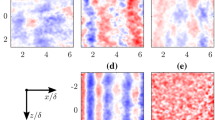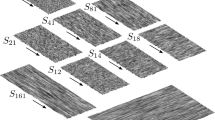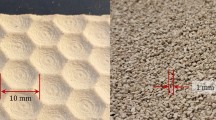Abstract
Modifications of fluid flow within microscale flow passages by internal surface roughness is investigated in the laminar, transitional, and turbulent regimes using pressure-drop measurements and instantaneous velocity fields acquired by microscopic particle-image velocimetry (micro-PIV). The microchannel under study is rectangular in cross-section with an aspect ratio of 1:2 (depth: width) and a hydraulic diameter of \(D_{\rm h} =600\,\upmu \hbox{m}.\) Measurements are first performed under smooth-wall conditions to establish the baseline flow characteristics within the microchannel followed by measurements for two different rough-wall cases [with RMS roughness heights of \(7.51\,\upmu \hbox{m}\) (0.0125D h) and \(15.1\,\upmu \hbox{m}\) (0.025D h)]. The roughness patterns under consideration are unique in that they are reminiscent of surface irregularities one might encounter in practical microchannels due to imperfect fabrication methods. The pressure-drop results reveal the onset of transition above \(Re_{\rm cr}=1{,}800\) for the smooth-wall case, consistent with the onset of transition at the macroscale, along with deviation from laminar behavior at progressively lower Re with increasing roughness. Mean velocity profiles computed from the micro-PIV ensembles at various Re for each surface condition confirm these trends, meaning \(Re_{\rm cr}\) is a strong function of roughness. The ensembles of velocity fields at each Re and surface condition in the transitional regime are subdivided into fields embodying laminar behavior and fields containing disordered motions. This decomposition reveals a clear hastening of the flow toward a turbulent state due both to the roughness dependence of Re cr and an enhancement in the growth rate of the non-laminar fraction of the flow when the flow is in the early stages of transition. Nevertheless, the range of Re relative to Re cr over which the flow transitions from a laminar to a turbulent state is found to be essentially the same for all three surface conditions. From a structural viewpoint, instantaneous velocity fields embodying disordered behavior in the transitional regime are found to contain large-scale motions consistent with hairpin-vortex packets irrespective of surface condition. These observations are in accordance with the characteristics of transitional and turbulent flows at the macroscale and therefore indicate that the overall structural paradigm of the flow is relatively insensitive to roughness. From a quantitative viewpoint, however, the intensity of both the velocity fluctuations and structural activity appear to increase substantially with increasing roughness, particularly in the latter stages of transition. These differences are further supported by the trends of single-point statistics of the non-laminar ensembles and quadrant analysis in which an intensification of the velocity fluctuations by surface roughness is noted in the region close to the wall, particularly for the wall-normal fluctuations.

















Similar content being viewed by others
References
Adrian RJ, Christensen KT, Liu ZC (2000a) Analysis and interpretation of instantaneous turbulent velocity fields. Exp Fluids 29:275–290
Adrian RJ, Meinhart CD, Tomkins CD (2000b) Vortex organization in the outer region of the turbulent boundary layer. J Fluid Mech 422:1–54
Christensen KT (2004) The influence of peak-locking errors on turbulence statistics computed from PIV ensembles. Exp Fluids 36:484–497
Christensen KT, Adrian RJ (2001) Statistical evidence of hairpin vortex packets in wall turbulence. J Fluid Mech 431:433–443
Christensen KT, Adrian RJ (2002) Measurement of instantaneous eulerian acceleration fields by particle-image accelerometry: method and accuracy. Exp Fluids 33:759–769
Christensen KT, Wu Y, Adrian RJ, Lai W (2004) Statistical imprints of structure in wall turbulence. AIAA paper 2004-1116
Colebrook CF (1939) Turbulent flow in pipes with particular reference to the transition region between the smooth- and rough-pipe laws. J Inst Civil Eng 11:133–156
Colebrook CF, White CM (1937) Experiments with fluid friction in roughened pipes. Proc R Soc Lond A 161:367–381
Darbyshire AG, Mullin T (1995) Transition to turbulence in a constant-mass-flux pipe flow. J Fluid Mech 289:83–114
Eggels JGM, Unger F, Weiss MH, Westerweel J, Adrian RJ, Friedrich R, Nieuwstadt FTM (1994) Fully developed turbulent pipe flow: a comparison between direct numerical simulation and experiment. J Fluid Mech 268:175–209
Ergu OB, Sara ON, Yapici S, Arzutugu ME (2009) Pressure drop and point mass transfer in a rectangular microchannel. Int Commun Heat Mass Transf 36(6):618–623
Ganapathisubramani B, Longmire EK, Marusic I (2003) Characteristics of vortex packets in turbulent boundary layers. J Fluid Mech 478:35–46
Ganapathisubramani B, Hutchins N, Hambleton WT, Longmire EK, Marusic I (2005) Investigation of large-scale coherence in a turbulent boundary layer using two-point correlations. J Fluid Mech 524:57–80
Hao PF, Yao ZH, He F, Zhu KQ (2006) Experimental investigation of water flow in smooth and rough silicon microchannels. J Micromech Microeng 16:1397
Hsieh SS, Lin CY, Huang CF, Tsai HH (2004) Liquid flow in a microchannel. J Micromech Microeng 14:436–445
Hutchins N, Marusic I (2007) Evidence of very long meandering features in the logarithmic region of turbulent boundary layers. J Fluid Mech 579:1–28
Idelchick IE (1986) Handbook of hydraulic resistance, chap 2. Hemisphere, New York
Jones OC (1976) An improvement in the calculation of turbulent friction in rectangular ducts. J Fluids Eng 98:173–181
Judy J, Maynes D, Webbs BW (2002) Characterization of frictional pressure drop for liquid flows through microchannels. Int J Heat Mass Transf 45:3477–3489
Kandlikar SG, Schmitt D, Carrano AL, Taylor JB (2005) Characterization of surface roughness effects on pressure drop in single-phase flow in minichannels. Phys Fluids 17:100606
Kline SJ, Robinson SK (1989) Quasi-coherent structures in the turbulent bounday layer. Part 1: status report on a community-wide summary of the data. Hemisphere, New York, pp 218–247
Li H, Olsen MG (2006a) Examination of large-scale structures in turbulent microchannel flow. Exp Fluids 40:733–743
Li H, Olsen MG (2006b) Aspect ratio effects in turbulent and transitional flow in rectangular microchannels as measured with micro-PIV. J Fluids Eng 128:305–315
Li H, Ewoldt R, Olsen MG (2005) Turbulent and transitional velocity measurements in a rectangular microchannel using microscopic particle image velocimetry. Exp Therm Fluid Sci 29:435–446
Liu ZC, Adrian RJ, Hanratty TJ (2001) Large-scale modes of turbulent channel flow: transport and structure. J Fluid Mech 448:53–80
Liu Z, Zhang C, Huo Y, Zhao X (2007) Flow and heat transfer in rough micro steel tubes. Exp Heat Transf 20:289–306
Lu SS, Willmarth WW (1973) Measurements of the structure of Reynolds stress in a turbulent boundary layer. J Fluid Mech 60:481–511
Mala GM, Li D (1999) Flow characteristics of water in microtubes. Int J Heat Fluid Flow 20:142–148
Meinhart CD, Wereley ST, Santiago JG (2000) PIV measurements of a microchannel flow. Exp Fluids 27:414–419
Moody LF (1944) Friction factors for pipe flow. Trans ASME 66:671
Morini GL (2004) Laminar-to-turbulent flow transition in microchannels. Microscale Thermophys Eng 8(1):15–30
Nakagawa S, Hanratty TJ (2001) Particle image velocimetry measurements of flow over a wavy wall. Phys Fluids 13(11):3504–3507
Natrajan VK, Christensen KT (2007) Microscopic particle image velocimetry measurements of transition to turbulence in microscale capillaries. Exp Fluids 43:1–16
Natrajan VK, Christensen KT (2009a) Structural characteristics of transition to turbulence in microscale capillaries. Phys Fluids 21 (034104)
Natrajan VK, Christensen KT (2009b) Non-intrusive measurements of convective heat transfer in smooth- and rough-wall microchannels. Part I: laminar flow. Exp Fluids (submitted)
Natrajan VK, Christensen KT (2009c) Non-intrusive measurements of convective heat transfer in smooth- and rough-wall microchannels. Part II: transitional and turbulent flow. Exp Fluids (submitted)
Natrajan VK, Yamaguchi E, Christensen KT (2007) Statistical and structural similarities between micro- and macro-scale wall turbulence. Microfluid Nanofluid 3:89–100
Nikuradse J (1933) Laws of flow in rough pipes. NACA Technical Memorandum (1292)
Obot NT (1988) Determination of incompressible flow friction in smooth circular and noncircular passages: a generalized approach including validation of the nearly century old hydraulic concept. J Fluids Eng 110:431–440
Olsen MG, Adrian RJ (2000) Out-of-focus effects on particle image visibility and correlation in microscopic particle image velocimetry. Exp Fluids 29:S166–S174
Peng XF, Peterson GP (1996) Convective heat transfer and flow friction for water flow in microchannel structures. Int J Heat Mass Transf 39:2599–2608
Peng XF, Peterson GP, Wang BX (1994) Frictional flow characteristics of water flowing through rectangular microchannels. Exp Heat Transf 7:249–264
Pfund D, Rector D, Shekarriz A, Popescu A, Welty J (2000) Pressure drop measurements in a microchannel. AIChE J 46:1496–1507
Prasad AK, Adrian RJ, Landreth CC, Offutt PW (1992) Effect of resolution on the speed and accuracy of particle image velocimetry interrogation. Exp Fluids 13:105–116
Qi SL, Zhang P, Wang RZ, Xu LX (2007) Single-phase pressure drop and heat transfer characteristics of turbulent liquid nitrogen flow in micro-tubes. Int J Heat Mass Transf 50(9–10):1993–2001
Qu W, Mudawar I (2002) Experimental and numerical study of pressure drop and heat transfer in a single-phase micro-channel heat sink. Int J Heat Mass Transf 45:2549–2565
Qu W, Mala GM, Li D (2000) Pressure driven water flows in trapeziodal silicon microchannels. Int J Heat Fluid Flow 43:353–364
Reynolds O (1883) An experimental investigation of circumstances which determine whether the motion of water shall be direct or continuous, and the law of resistance in parallel channels. Philos Trans R Soc Lond 174:935–982
Santiago JG, Wereley ST, Meinhart CD, Beebe DJ, Adrian RJ (1998) A particle image velocimetry system for microfluidics. Exp Fluids 25:316–319
Schlichting H (1979) Boundary-layer theory. McGraw-Hill, New York
Schröder A, Kompenhans J (2004) Investigation of a turbulent spot using multi-plane stereo particle image velocimetry. Exp Fluids 36:82–90
Shah RK, London AL (1978) Laminar flow forced convection in ducts (Advances in heat transfer, supplement 1). Academic Press, New York
Sharp KV, Adrian RJ (2004) Transition from laminar to turbulent flow in liquid filled microtubes. Exp Fluids 36:741–747
Volino RJ, Schultz MP, Flack KA (2007) Turbulence structure in rough- and smooth-wall boundary layers. J Fluid Mech 592:263–293
Wang BX, Peng XF (1994) Experimental investigation on liquid forced-convection heat transfer through microchannels. Int J Heat Mass Transf 37:73–82
Westerweel J (1997) Fundamentals of digital particle image velocimetry. Meas Sci Technol 8:1379–1392
Wu P, Little W (1984) Measuring of heat transfer characteristics of gas flow in fine channel heat exchangers for micro miniature refrigerators. Cryogenics 24:415–420
Wu Y, Christensen KT (2007) Outer-layer similarity in the presence of a practical rough-wall topography. Phys Fluids 19:085108
Wygnanski IJ, Champagne FH (1973) On transition in a pipe. Part 1. The origin of puffs and slugs and the flow in a turbulent slug. J Fluid Mech 59:281–335
Wygnanski IJ, Sokolov M, Friedman D (1975) On transition in a pipe. Part 2. The equilibrium puff. J Fluid Mech 69:283–304
Yang CY, Wu JC, Chien HT, Lu SR (2003) Friction characteristics of water, R134a, and air in small tubes. Microscale Thermophys Eng 7:335–348
Zhou J, Adrian RJ, Balachandar S, Kendall TM (1999) Mechanisms for generating coherent packets of hairpin vortices in channel flow. J Fluid Mech 387:353–396
Acknowledgments
This work is supported by the Air Force Office of Scientific Research under grant FA9550-05-1-0346 (Drs. Les Lee and Hugh DeLong, Program Managers) and the University of Illinois.
Author information
Authors and Affiliations
Corresponding author
Rights and permissions
About this article
Cite this article
Natrajan, V.K., Christensen, K.T. The impact of surface roughness on flow through a rectangular microchannel from the laminar to turbulent regimes. Microfluid Nanofluid 9, 95–121 (2010). https://doi.org/10.1007/s10404-009-0526-2
Received:
Accepted:
Published:
Issue Date:
DOI: https://doi.org/10.1007/s10404-009-0526-2




